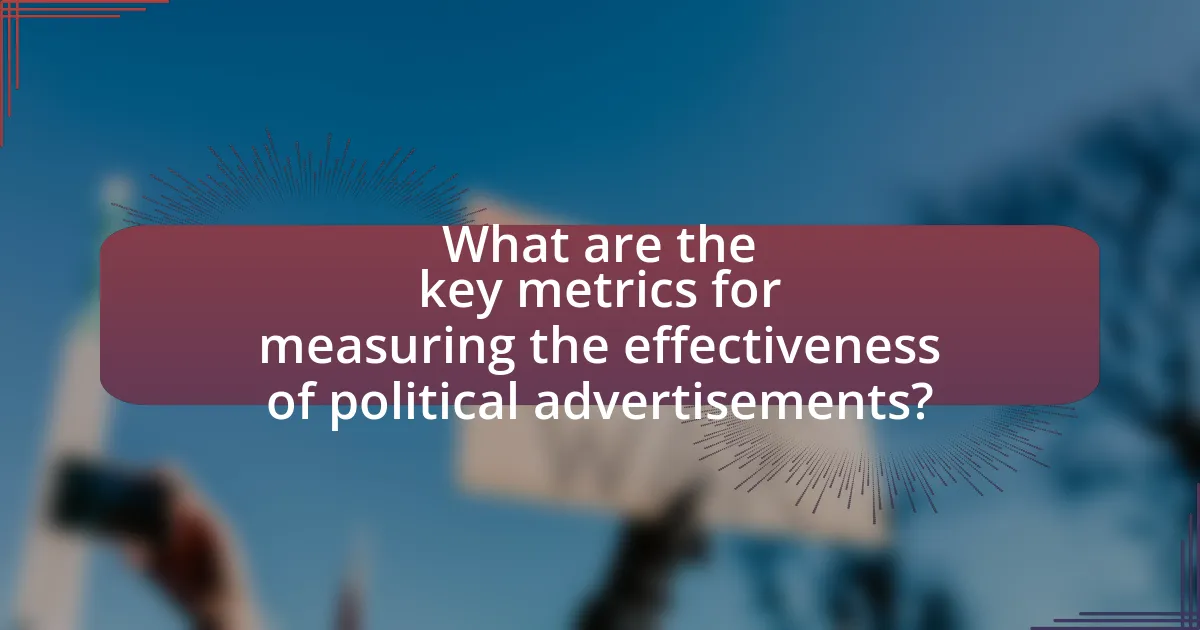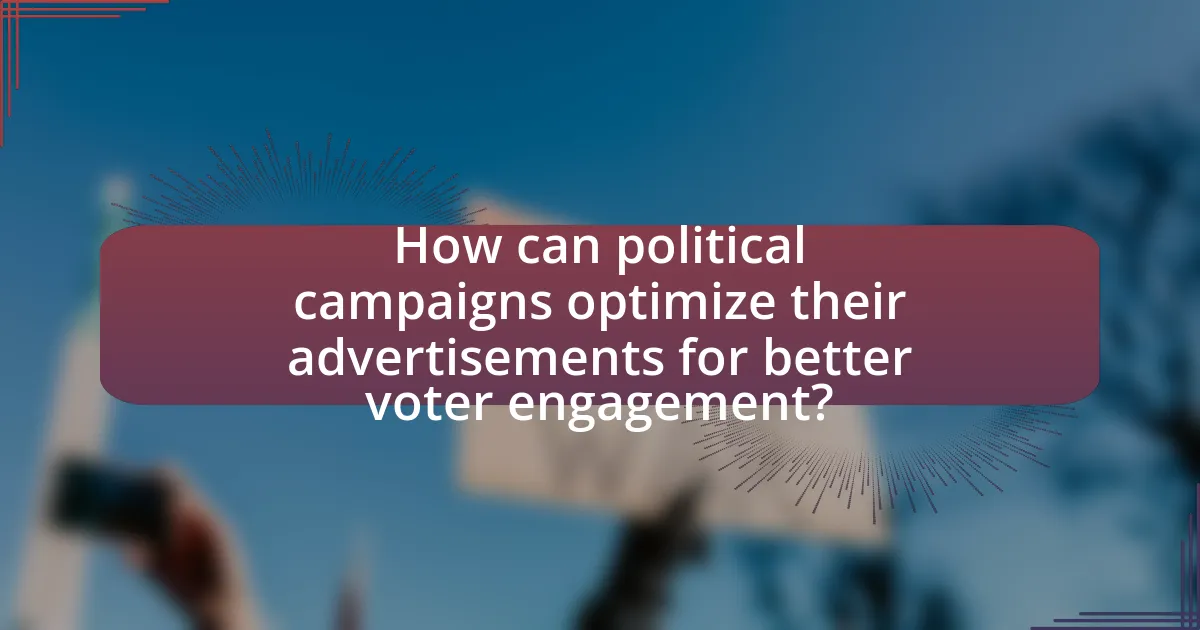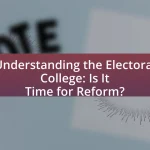The article analyzes the effectiveness of political advertisements on voter behavior, highlighting their significant influence on shaping perceptions and increasing candidate recognition. It discusses various types of political ads, including positive, negative, contrast, and issue-based ads, and examines the psychological factors at play, such as emotional appeals and cognitive biases. Key metrics for measuring advertisement effectiveness, including reach, engagement, and conversion rates, are outlined, along with strategies for optimizing campaign advertisements to enhance voter engagement. The article also addresses the implications of advertisement analysis for democracy and future trends in political advertising.

What is the Effectiveness of Political Advertisements on Voter Behavior?
Political advertisements significantly influence voter behavior by shaping perceptions and increasing candidate recognition. Research indicates that exposure to political ads can lead to changes in voter preferences, particularly among undecided voters. For instance, a study by the Pew Research Center found that 62% of voters reported that political ads helped them learn about candidates’ positions. Additionally, the effectiveness of these advertisements often varies based on factors such as the medium used (television, online, etc.) and the timing of the ads relative to the election date. Overall, political advertisements play a crucial role in informing and persuading voters, ultimately impacting electoral outcomes.
How do political advertisements influence voter decisions?
Political advertisements significantly influence voter decisions by shaping perceptions and attitudes toward candidates and issues. Research indicates that these advertisements can enhance name recognition, create emotional responses, and frame political narratives, which ultimately guide voter preferences. For instance, a study by the Pew Research Center found that 62% of voters reported that advertisements helped them decide whom to vote for in the 2020 election. Additionally, advertisements that utilize persuasive messaging and targeted demographics can effectively sway undecided voters, as evidenced by the success of tailored ads in swing states during recent elections.
What psychological factors are at play in political advertising?
Psychological factors in political advertising include emotional appeal, social proof, and cognitive biases. Emotional appeal targets feelings such as fear, hope, or anger to influence voter decisions, as demonstrated by studies showing that emotionally charged messages can significantly increase engagement and persuasion. Social proof leverages the tendency of individuals to look to others for guidance, often seen in advertisements that highlight endorsements or popular support for a candidate. Cognitive biases, such as confirmation bias, lead voters to favor information that aligns with their pre-existing beliefs, making targeted messaging more effective. Research indicates that these psychological elements can enhance the effectiveness of political advertisements by shaping perceptions and behaviors among voters.
How do emotional appeals in advertisements affect voter perception?
Emotional appeals in advertisements significantly influence voter perception by creating strong psychological connections that can sway opinions and behaviors. Research indicates that advertisements that evoke emotions such as fear, hope, or empathy can enhance message retention and increase the likelihood of voter engagement. For instance, a study published in the Journal of Advertising Research found that emotionally charged political ads led to a 20% increase in voter recall compared to neutral ads. This demonstrates that emotional content not only captures attention but also shapes how voters perceive candidates and their messages, ultimately impacting electoral outcomes.
What types of political advertisements exist?
Political advertisements exist in several types, including positive ads, negative ads, contrast ads, and issue-based ads. Positive ads promote a candidate’s qualifications and achievements, while negative ads attack an opponent’s character or record. Contrast ads highlight the differences between candidates, emphasizing their opposing views or policies. Issue-based ads focus on specific topics, such as healthcare or education, aiming to sway voters based on their stance on these issues. Each type serves distinct strategic purposes in influencing voter behavior during elections.
How do negative advertisements impact voter behavior?
Negative advertisements significantly influence voter behavior by increasing voter turnout and shaping perceptions of candidates. Research indicates that exposure to negative ads can lead to heightened emotional responses, such as anger or fear, which often mobilizes voters to participate in elections. For instance, a study published in the Journal of Politics found that negative campaigning can increase voter turnout by as much as 5% in competitive races. Additionally, negative advertisements can alter voters’ perceptions of candidates, often leading to a decrease in favorability ratings for the targeted candidate. This effect is particularly pronounced among undecided voters, who may be swayed by the negative information presented.
What role do positive advertisements play in shaping voter opinions?
Positive advertisements significantly influence voter opinions by highlighting candidates’ strengths and appealing to voters’ emotions. These advertisements create a favorable image of the candidate, which can lead to increased support and trust among the electorate. Research indicates that positive messaging can enhance voter engagement and turnout; for instance, a study by the American Political Science Review found that positive ads are more effective in increasing voter preference than negative ads. This effectiveness stems from the ability of positive advertisements to resonate with voters’ values and aspirations, ultimately shaping their perceptions and decisions at the polls.
Why is it important to analyze political advertisements?
Analyzing political advertisements is crucial because it reveals their impact on voter behavior and decision-making. Political ads are designed to influence public perception and can significantly sway election outcomes; for instance, a study by the Pew Research Center found that 62% of voters reported that ads influenced their choices in the 2020 election. Understanding the strategies and messages used in these advertisements allows researchers and political strategists to assess their effectiveness and ethical implications, ultimately shaping future campaign tactics and voter engagement strategies.
How can understanding advertisement effectiveness improve campaign strategies?
Understanding advertisement effectiveness can significantly enhance campaign strategies by enabling targeted messaging and resource allocation. By analyzing metrics such as engagement rates, conversion rates, and audience demographics, campaign managers can identify which advertisements resonate most with voters. For instance, a study by the American Political Science Review found that campaigns that utilized data-driven insights to tailor their advertisements saw a 20% increase in voter engagement compared to those that did not. This evidence demonstrates that leveraging advertisement effectiveness leads to more efficient campaigns, ultimately improving voter outreach and influencing voter behavior.
What implications does advertisement analysis have for democracy?
Advertisement analysis significantly impacts democracy by revealing how political messaging influences voter behavior and public opinion. Understanding the effectiveness of advertisements allows for the identification of persuasive techniques that can shape electoral outcomes, thereby affecting democratic processes. For instance, studies have shown that targeted political ads can increase voter turnout by as much as 10% in specific demographics, highlighting their power in mobilizing support. Furthermore, analyzing the content and reach of these advertisements can expose potential misinformation or bias, fostering a more informed electorate. This scrutiny is essential for maintaining transparency and accountability in political communication, which are foundational elements of a healthy democracy.

What are the key metrics for measuring the effectiveness of political advertisements?
The key metrics for measuring the effectiveness of political advertisements include reach, engagement, conversion rates, and return on investment (ROI). Reach quantifies the number of individuals exposed to the advertisement, indicating its potential audience size. Engagement measures interactions such as likes, shares, and comments, reflecting how well the ad resonates with viewers. Conversion rates track the percentage of viewers who take a desired action, such as registering to vote or donating, demonstrating the ad’s impact on voter behavior. ROI assesses the financial return relative to the cost of the advertisement, providing insight into its overall effectiveness. These metrics collectively offer a comprehensive evaluation of how political advertisements influence voter behavior and campaign success.
How is voter engagement assessed in relation to advertisements?
Voter engagement in relation to advertisements is assessed through metrics such as reach, frequency, and impact on voter attitudes and behaviors. Researchers analyze data from surveys, focus groups, and social media interactions to gauge how advertisements influence voter awareness and motivation to participate in elections. For instance, studies have shown that targeted advertisements can increase voter turnout by as much as 10%, indicating a direct correlation between ad exposure and voter engagement. Additionally, tracking online engagement metrics, such as clicks and shares, provides quantitative evidence of how effectively advertisements resonate with potential voters.
What methods are used to track changes in voter sentiment?
Surveys and polls are the primary methods used to track changes in voter sentiment. These tools gather data on public opinion by asking respondents about their preferences, attitudes, and perceptions regarding candidates and issues. For instance, Gallup and Pew Research Center frequently conduct national surveys that provide insights into shifts in voter sentiment over time, reflecting changes in political attitudes and behaviors. Additionally, social media analysis and sentiment analysis algorithms are increasingly employed to gauge public opinion by analyzing online discussions and interactions, offering real-time insights into voter sentiment trends.
How do surveys and polls contribute to understanding advertisement impact?
Surveys and polls provide quantitative data that helps measure the effectiveness of advertisements on voter behavior. By collecting responses from targeted demographics, these tools assess how well advertisements resonate with audiences, influencing their perceptions and voting intentions. For instance, a study by the Pew Research Center found that 70% of voters reported being influenced by campaign ads, highlighting the direct correlation between advertisement exposure and voter decision-making. This data allows political strategists to refine their messaging and allocate resources effectively, ensuring that advertisements are tailored to maximize impact on voter behavior.
What role does media reach play in advertisement effectiveness?
Media reach significantly influences advertisement effectiveness by determining the number of potential viewers exposed to the ad. A broader media reach increases the likelihood of engaging a larger audience, which can enhance brand awareness and message retention. For instance, studies show that advertisements with extensive reach can lead to a 30% increase in consumer recall compared to those with limited exposure. This correlation underscores the importance of selecting media channels that maximize audience reach to optimize the impact of political advertisements on voter behavior.
How does the choice of media platform affect voter response?
The choice of media platform significantly affects voter response by influencing the reach, engagement, and perception of political advertisements. Different platforms, such as television, social media, and print, have varying audience demographics and engagement levels; for instance, social media platforms like Facebook and Twitter allow for targeted advertising that can engage younger voters more effectively than traditional media. Research indicates that 60% of voters aged 18-29 reported being influenced by social media ads during elections, compared to only 30% for television ads. This demonstrates that the effectiveness of political advertisements is closely tied to the media platform used, as each platform shapes voter interaction and information dissemination differently.
What is the significance of ad frequency in influencing voter behavior?
Ad frequency significantly influences voter behavior by increasing the likelihood of message retention and shaping perceptions of candidates. Research indicates that higher ad frequency leads to greater familiarity, which can enhance voter trust and preference. For instance, a study by the American Political Science Review found that voters exposed to campaign ads multiple times were more likely to recall the candidate’s key messages and express favorable opinions. This effect is particularly pronounced in competitive races, where repeated exposure can sway undecided voters and solidify support among committed ones.

How can political campaigns optimize their advertisements for better voter engagement?
Political campaigns can optimize their advertisements for better voter engagement by utilizing data analytics to target specific demographics effectively. By analyzing voter behavior and preferences through data collection methods such as surveys and social media analytics, campaigns can tailor their messages to resonate with particular groups. For instance, a study by the Pew Research Center found that targeted ads can increase engagement rates by up to 50% when they align with the interests and values of the audience. Additionally, employing A/B testing allows campaigns to refine their messaging and visuals based on real-time feedback, ensuring that advertisements are both relevant and compelling.
What strategies can be employed to enhance advertisement effectiveness?
To enhance advertisement effectiveness, employing targeted messaging is crucial. Targeted messaging involves tailoring advertisements to specific demographics, interests, and behaviors, which increases relevance and engagement. Research indicates that personalized ads can lead to a 20% increase in conversion rates, as they resonate more with the audience’s preferences and needs. Additionally, utilizing data analytics to track audience responses allows for real-time adjustments to campaigns, further optimizing effectiveness. A study by the Interactive Advertising Bureau found that campaigns leveraging data-driven strategies saw a 30% improvement in overall performance metrics.
How can targeting specific demographics improve campaign outcomes?
Targeting specific demographics can significantly improve campaign outcomes by ensuring that messages resonate with the intended audience. When campaigns tailor their strategies to the preferences, values, and behaviors of specific demographic groups, they increase engagement and relevance, leading to higher conversion rates. For instance, research by the Pew Research Center indicates that targeted political advertisements can lead to a 20% increase in voter turnout among specific age groups when messages align with their interests and concerns. This targeted approach allows campaigns to allocate resources more efficiently, maximizing impact and fostering stronger connections with voters.
What role does message clarity play in voter understanding?
Message clarity significantly enhances voter understanding by ensuring that political messages are easily comprehensible and relatable. Clear messages reduce ambiguity, allowing voters to grasp key issues and candidates’ positions effectively. Research indicates that voters are more likely to engage with and retain information from advertisements that present straightforward and concise messaging. For instance, a study published in the Journal of Communication found that clarity in political messaging correlates with increased voter knowledge and engagement, demonstrating that voters exposed to clear messages are 25% more likely to accurately recall candidates’ platforms compared to those exposed to vague or complex messages.
What best practices should campaigns follow when creating political advertisements?
Campaigns should prioritize clarity, authenticity, and targeting when creating political advertisements. Clear messaging ensures that the audience easily understands the candidate’s platform and values, which is crucial for effective communication. Authenticity builds trust; voters are more likely to engage with candidates who present genuine narratives rather than overly polished or scripted messages. Targeting specific demographics allows campaigns to tailor their advertisements to resonate with particular voter groups, increasing the likelihood of engagement and support. Research indicates that targeted ads can significantly enhance voter turnout, as seen in the 2012 U.S. presidential election, where tailored messaging contributed to increased voter mobilization efforts.
How can campaigns effectively balance emotional and rational appeals?
Campaigns can effectively balance emotional and rational appeals by integrating storytelling with factual data. Emotional appeals engage voters on a personal level, fostering connection and empathy, while rational appeals provide logical reasoning and evidence to support claims. Research indicates that advertisements combining both elements can enhance persuasion; for instance, a study by the American Psychological Association found that messages that evoke emotions while presenting factual information lead to higher retention and influence voter decisions. By strategically using narratives that resonate emotionally alongside statistics or expert endorsements, campaigns can create a compelling message that motivates voters to act.
What common pitfalls should be avoided in political advertising?
Common pitfalls to avoid in political advertising include misleading information, lack of target audience understanding, and failure to adapt to changing voter sentiments. Misleading information can damage credibility and lead to backlash, as seen in the 2016 U.S. presidential election where false claims circulated widely. Not understanding the target audience can result in ineffective messaging; for instance, ads that do not resonate with specific demographics may fail to engage voters. Additionally, failing to adapt to changing voter sentiments can render campaigns obsolete, as demonstrated by the rapid shifts in public opinion during election cycles.
What are the future trends in political advertising and voter behavior analysis?
Future trends in political advertising and voter behavior analysis include increased use of artificial intelligence for targeted messaging, greater emphasis on data privacy, and the rise of social media influencers in campaigns. Political campaigns are increasingly leveraging AI to analyze voter data, allowing for hyper-targeted advertisements that resonate with specific demographics. According to a 2022 study by the Pew Research Center, 70% of voters reported that personalized ads influenced their voting decisions, highlighting the effectiveness of this approach. Additionally, as regulations around data privacy tighten, campaigns will need to adapt their strategies to comply with laws like the General Data Protection Regulation (GDPR) in Europe, which impacts how voter data is collected and used. Furthermore, the influence of social media personalities is growing; a 2023 report from the Digital Marketing Institute found that 60% of younger voters are swayed by endorsements from influencers, indicating a shift in how campaigns engage with potential voters.





